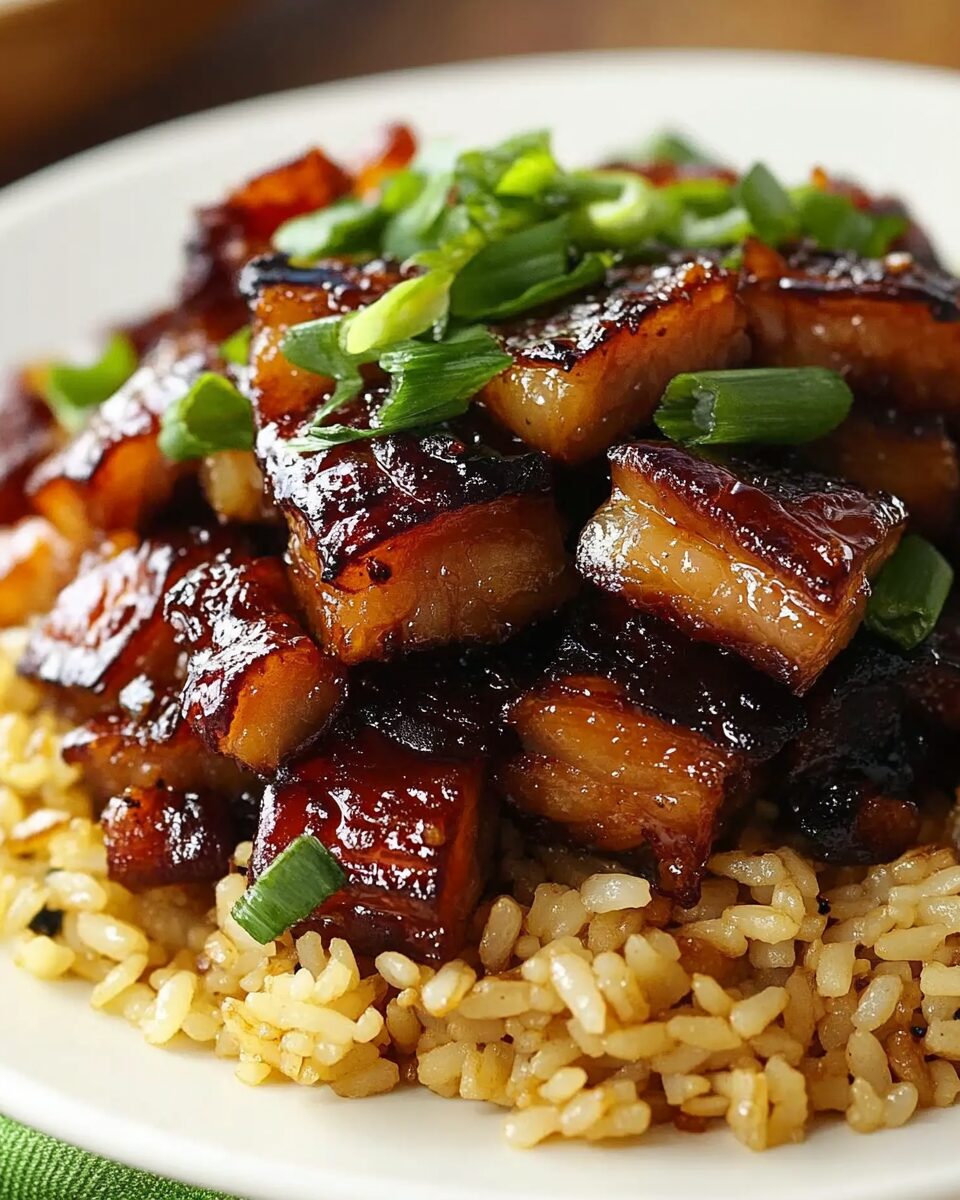This Pork Belly Sticky Rice is a celebration of texture and deep umami flavors. Tender pork belly is slow-cooked until melt-in-your-mouth soft, then seared and coated in a sweet-salty sauce with a hint of lemongrass and five-spice. The sticky rice, infused with soy, sesame oil, and Shaoxing wine, is steamed to perfection and tossed with shiitake mushrooms, Chinese sausage, and bok choy for an aromatic, one-pan wonder.
Perfect for weekend cooking or sharing at family gatherings, this dish draws from traditional Chinese comfort food but is layered with flavor complexity that feels special. It’s deeply savory, just the right amount of sweet, and immensely satisfying. The bold ingredients work together harmoniously, making each bite exciting and memorable. Serve it hot straight from the pan or mold it into individual bowls for an elevated presentation.
Full Recipe
Ingredients:
For the Sticky Rice:
-
2 cups Sweet Rice (Glutinous Rice)
For the Slow Cooked Pork Belly:
-
1 lb Thick Pork Belly Slices (rindless, cut into 3-inch pieces)
-
2 cups Chicken Broth
-
1 Thumb-sized Piece of Ginger (peeled and minced)
-
3 Garlic Cloves (roughly chopped)
-
½ Tbsp Mirin
-
½ Tbsp Granulated Sugar
For the Pork Belly Sauce:
-
2 Tbsp Brown Sugar
-
3 Tbsp Dark Soy Sauce
-
1 tsp Lemongrass Paste
-
1 Thumb-sized Piece of Ginger (peeled and minced)
-
¼ tsp Chinese Five Spice
-
¼ tsp Kosher Salt
-
Dash of White Pepper
For the Sticky Rice Sauce:
-
1 Tbsp Dark Soy Sauce
-
2 Tbsp Soy Sauce
-
1 Tbsp Brown Sugar
-
1 Tbsp Shaoxing Wine
-
2 tsp Sesame Oil
-
1 tsp Kosher Salt
-
Pinch of White Pepper
For the Sticky Rice Mix-ins:
-
3 ½ Tbsp Vegetable Oil
-
2 Garlic Cloves (minced)
-
2 tsp Minced Ginger
-
3 Green Onions (sliced, white and green parts separated)
-
7 oz Fresh Shiitake Mushrooms (sliced, about 3 cups)
-
3 Chinese Sausage Links (sliced on a bias)
-
2 Medium Bok Choy (chopped, about 3 cups)
-
½ Tbsp Sesame Oil
-
½ cup Chicken Broth
Directions:
-
Soak the Sticky Rice: The day before, add the sweet rice to a bowl and fill it with water. Set it aside and allow the rice to soak overnight.
-
Cook the Pork Belly: Add all of the slow-cooked pork belly ingredients to a slow cooker. Mix until the sugar dissolves. Cook on high for 3 ½ to 4 hours until the pork belly is tender. Alternatively, add all the ingredients to a pot and mix. Heat over high heat until it comes to a boil. Reduce the heat to low. Cover and simmer for about 2-3 hours until the pork belly is tender. Periodically check to make sure there is still enough chicken broth in the pot. Add more if needed.
-
Prepare the Pork Belly Sauce: In a bowl, combine brown sugar, dark soy sauce, lemongrass paste, ginger, Chinese five spice, salt, and white pepper. Set aside.
-
Prepare the Sticky Rice Sauce: In another bowl, combine dark soy sauce, soy sauce, brown sugar, Shaoxing wine, sesame oil, salt, and white pepper. Set aside.
-
Steam the Sticky Rice: Drain the water from the soaked rice. Line a steamer basket with parchment paper. Fill a large pan with about an inch of water. Place a steaming rack in the center. Heat it over medium-high heat until it comes to a simmer. Reduce the heat to low so that the water is gently bubbling. Place the steamer basket onto the rack. Cover the pan with a lid and steam the rice until mostly tender, about 25-30 minutes. When the rice is cooked, remove it from the pan and set it aside.
-
Sear the Pork Belly: Pat the pork belly pieces dry with paper towels. Heat a large pan or wok over medium-high heat. Add the pork belly pieces and cook for about 1-2 minutes per side until the pork belly is seared and golden brown. Pour in the pork belly sauce and cook for 1-2 minutes until all the pieces have absorbed and are coated in the sauce. Remove the pork belly from the pan and set it aside.
-
Sauté the Mix-ins: Wipe out the pan with paper towels. Pour in 2 tablespoons of vegetable oil into the same pan. Add the garlic, ginger, and the white parts of the green onions. Sauté for 1 minute then add in the shiitake mushrooms. Cook for about 3 minutes until the mushrooms are cooked halfway then add in the Chinese sausage. Mix and cook for 2-3 minutes until the sausages have browned. Add in the bok choy and cook until the greens have wilted. Remove the ingredients from the pan and set aside.
-
Combine Everything: In the same pan, add in the remaining ½ tablespoon of vegetable oil and the sesame oil. Heat over medium-high heat then add in the sticky rice. Break the rice apart then pour in the sticky rice sauce. Mix until each grain of rice is coated in the sauce. Add in the pork belly and the sautéed mix-ins. Mix and cook for about 2 minutes. Pour in the chicken broth and the green parts of the green onion. Mix to combine then cover the pan with a lid and cook over medium-low heat for 5 minutes.
-
Final Touches: Remove the pan from heat. Mix and taste. Season with additional salt and white pepper if needed. Serve hot and enjoy!
Prep Time: 1 hour 15 minutes | Cooking Time: 4 hours 45 minutes | Total Time: 6 hours | Kcal: Approximately 600 kcal per serving | Servings: 6 servings
The Cultural Roots of Pork Belly Sticky Rice
Pork Belly Sticky Rice is more than just a meal—it’s a deeply rooted cultural dish that reflects generations of culinary tradition across East and Southeast Asia. Known in Cantonese as “Lo Mai Fan” (糯米饭), this dish is a staple during Lunar New Year celebrations, family gatherings, and festival meals. Its composition is both humble and luxurious: the sticky (glutinous) rice provides a warm, chewy base, while the rich pork belly and seasoned toppings elevate it into a festive treat.
In many Asian cultures, sticky rice symbolizes unity and prosperity. Its cohesive texture represents family togetherness, making it an essential dish during holidays and special occasions. The inclusion of pork belly and other umami-rich ingredients also reflects a deep respect for flavors that are bold yet balanced—sweet, salty, and aromatic, all in harmony.
A Harmony of Flavors and Textures
One of the most remarkable qualities of Pork Belly Sticky Rice is its texture. The glutinous rice absorbs all the flavors of the sauces and ingredients while maintaining its signature chewiness. This contrast between the soft rice, the tender pork belly, the snappy Chinese sausage, and the umami-rich shiitake mushrooms creates a multi-layered experience in every bite.
The pork belly itself is typically slow-cooked until the fat renders down and the meat becomes melt-in-your-mouth tender. It’s then seared for a crispy edge and coated in a dark, glossy sauce infused with soy, brown sugar, ginger, and Chinese five-spice. This creates a rich umami foundation that plays beautifully against the natural sweetness of the Chinese sausage and the earthy mushrooms.
Ingredient Spotlight: Sticky Rice and Pork Belly
Glutinous rice, also known as sweet rice or sticky rice, is key to the dish’s signature texture. Unlike regular long-grain rice, sticky rice is opaque and starchy. It requires an overnight soak and a gentle steaming process rather than boiling. This traditional method allows it to stay firm yet sticky, perfect for holding together all the ingredients in the final dish.
Pork belly, meanwhile, is a luxurious cut prized for its layers of meat and fat. When slow-cooked, the fat slowly melts into the dish, enriching everything it touches. In this recipe, the pork belly is not just cooked; it’s infused. Aromatics like ginger and garlic, combined with mirin and chicken broth, give the pork a deep, nuanced flavor that lingers on the palate.
Aromatics and Seasonings: The Heart of the Dish
The seasoning base for Pork Belly Sticky Rice is where the magic happens. This dish utilizes multiple layers of flavor through sauces tailored to each cooking stage. First, the pork is seasoned and braised in a savory broth. Then, a sticky glaze is applied to the pork belly during searing, caramelizing slightly in the pan. Finally, a soy-based sauce is added to the steamed rice, ensuring that every grain is flavorful.
The use of Chinese five-spice adds complexity with notes of star anise, clove, fennel, Sichuan peppercorns, and cinnamon. Lemongrass paste gives the pork a subtle citrusy note, balancing the heaviness of the fat. These carefully chosen ingredients combine in a masterful way that shows the depth of thought in Asian cooking traditions.
Adding Depth with Chinese Sausage and Shiitake Mushrooms
Lap cheong, or Chinese sausage, is a cured, slightly sweet sausage that brings an unmistakable fragrance to the dish. When pan-seared, it releases flavorful oils that mingle with the mushrooms and greens. Its sweetness provides a sharp but pleasant contrast to the savory notes of the pork belly.
Shiitake mushrooms, known for their meaty texture and deep umami character, are a classic pairing with both pork and sticky rice. When sautéed with garlic and ginger, they become rich and aromatic. These mushrooms not only enhance the overall flavor but also provide balance, ensuring the dish isn’t overly heavy.
Nutritional Value and Comfort Food Appeal
While rich, this dish provides a well-rounded balance of protein, fats, and carbohydrates. The inclusion of bok choy brings in fiber and a slight bitterness that cuts through the richness of the meat. Aromatics like ginger and garlic offer both flavor and digestion-aiding properties, which is especially appreciated in more indulgent meals.
Comfort food isn’t just about caloric satisfaction—it’s about nostalgia, connection, and warmth. Pork Belly Sticky Rice ticks all those boxes. Whether you’re recreating a dish from your childhood or trying it for the first time, it has a way of wrapping you in a sense of comfort and tradition.
Serving Suggestions and Presentation Tips
Pork Belly Sticky Rice is best served hot and fresh, though it can also be made ahead and reheated gently in a steamer or covered skillet. For a traditional presentation, serve it in small bowls or ramekins, packing the sticky rice tightly so that it can be inverted onto a plate. Garnish with thinly sliced green onions, toasted sesame seeds, or a drizzle of sesame oil for extra visual appeal.
For an elegant dinner party, serve in banana leaf cups or small bamboo steamers to bring in a rustic, authentic charm. It also pairs well with pickled vegetables or a light soup to cut the richness and round out the meal.
Why This Dish Stands the Test of Time
Pork Belly Sticky Rice has endured for centuries for good reason. It’s adaptable—easy to tweak based on ingredient availability, dietary preferences, or time constraints. It can be cooked in large batches and keeps well, making it perfect for feeding families or preparing for holiday gatherings.
More importantly, it tells a story. A story of migration, adaptation, and cultural preservation. In every family kitchen where this dish is made, there is a lineage of home cooks passing on secrets, adjusting seasoning, and perfecting the cooking technique just a little more each time.
Conclusion
Pork Belly Sticky Rice is not just another rice dish—it’s an expression of culinary heritage. It combines artistry with comfort, simplicity with complexity, and tradition with personal creativity. Learning to make it from scratch offers not only a delicious reward but also a deeper appreciation for the cultural roots it represents.
For those looking to explore Asian cuisine more deeply or simply searching for a dish that satisfies on every level—texture, flavor, aroma, and nostalgia—Pork Belly Sticky Rice is a must-try. It’s a labor of love, yes, but one that pays off in unforgettable bites and shared memories.






